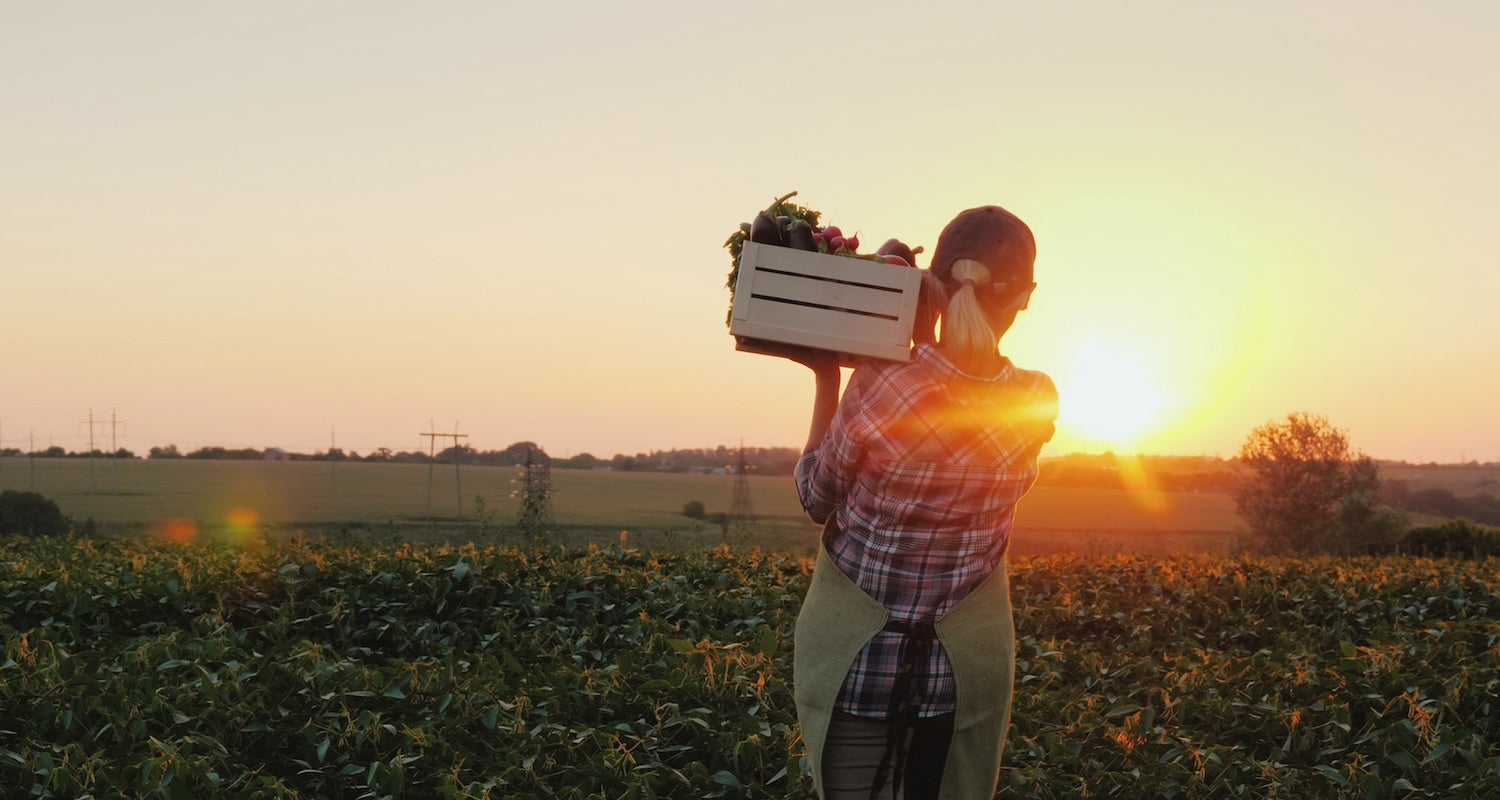
Whole Foods, Whole Microbiome – Why Diversity is Key to a Healthy Gut
Healing From the Soil Up
So far in our Gut Health Series, we’ve explored how digestion works, why stomach acid and enzymes are essential, how your gut lining keeps the good in and the bad out, and the powerful role your microbiome plays in everything from digestion to immunity to mood.
In this post, we’re focusing on one of the most impactful (and often overlooked) ways to support gut health: whole foods—especially those rich in fiber, polyphenols, and plant diversity.
Because when it comes to nourishing your microbiome, what you eat every day sends the strongest signal of all.
Whole Foods = Whole Microbiome Support 🥬
When most people think of gut health, they usually turn to probiotics, yogurt, or maybe a kombucha. And while those can help, they only just scratch the surface.
The real secret to a thriving microbiome? Diversity—especially in your diet.
Your gut microbiome—the vast community of trillions of bacteria, fungi, and other microbes living mostly in your colon—needs more than just live cultures. It needs consistent, diverse nourishment from whole foods.
Why? Because your microbes eat what you eat.
And the more variety, color, and fiber you give them, the more balanced and resilient your internal ecosystem becomes.

When most people think of gut health, they usually turn to probiotics, yogurt, or maybe a kombucha. And while those can help, they’re only just scratch the surface.
The real secret to a thriving microbiome? Diversity—especially in your diet.
Your gut microbiome—the vast community of trillions of bacteria, fungi, and other microbes living mostly in your colon—needs more than just live cultures. It needs consistent, diverse nourishment from whole foods.
Why? Because your microbes eat what you eat.
And the more variety, color, and fiber you give them, the more balanced and resilient your internal ecosystem becomes.

Why Diversity Matters Most
Different types of beneficial bacteria thrive on different kinds of fiber, polyphenols, and plant compounds. When you eat the same ten foods every week, you feed the same types of microbes—leaving others undernourished and your microbial community less diverse.
But when you rotate your foods, try new veggies, and eat a colorful plate?
You invite more species to thrive—and that leads to better digestion, immunity, energy, and even mental clarity.
Tip: Aim for 30+ different whole foods per week. That includes fruits, vegetables, legumes, whole grains, herbs, spices, nuts, and seeds.
Don’t get stuck eating the same handful of “healthy” foods on repeat. The best thing you can do for your gut is to eat a wide range of whole foods—every day.
Don’t get stuck eating the same handful of “healthy” foods on repeat. The best thing you can do for your gut is to eat a wide range of whole foods—every day.
How Whole Foods Feed Your Microbiome
Here's what makes whole foods so microbiome-friendly:
🥬 Fiber: The Microbiome’s Favorite Fuel
🥬 Fiber: The Microbiome’s Favorite Fuel
Fiber isn’t just about staying regular—it’s one of the most powerful tools for building a healthier, more resilient microbiome. But not all fiber works the same way. Some types help bulk your stool and keep digestion moving, while others act as prebiotics—special compounds that resist digestion in the small intestine and make it all the way to the colon, where they become fuel for your gut microbes.
Once there, your microbes ferment these prebiotics into short-chain fatty acids (SCFAs)—including butyrate, acetate, and propionate. These SCFAs are postbiotics: powerful compounds that act like compost for your gut, nourishing the environment and helping your entire digestive ecosystem thrive.
SCFAs help:
- Nourish and repair your gut lining
- Promote the growth of helpful bacteria
- Calm inflammation and support immune function
- Improve regularity
- Regulate blood sugar and metabolism
👉 It’s a beautiful feedback loop:
You feed your microbes → they create SCFAs → SCFAs help your gut (and you) flourish
Short-chain fatty acids are one of the most important and well-studies postbiotics
Short-chain fatty acids are one of the most important and well-studies postbiotics
Whole Food Fiber > Fiber Supplements
Fiber from whole foods (like fruits, veggies, legumes, and whole grains) comes bundled with polyphenols, antioxidants, enzymes, and other synergistic nutrients that support microbial diversity, gut lining health, and overall digestion.
Fiber supplements can have their place, especially for targeted support, but they’re often missing the full nutritional package. Without the co-factors found in real food, they may not offer the same benefits—and can sometimes ferment too quickly, leading to gas or bloating
👉 The key is to get a variety of fiber from real, colorful, minimally processed whole foods that feed your gut in more ways than one.
The Different Types + Roles of Fiber
-
Soluble Fiber – oats, beans, apples, flax
✅ Usually prebiotic
✅ Feeds gut bacteria and helps regulate blood sugar -
Insoluble Fiber – whole grains, leafy greens
❎ Not considered prebiotic
✅ Adds bulk to stool and supports regularity (without much fermentation) -
Resistant Starch – green bananas, legumes, cooled potatoes + rice
✅ Prebiotic
✅ Great for microbial diversity and SCFA production -
Pectin – apples, citrus, berries
✅ Prebiotic
✅ Ferments slowly to reduce inflammation and feed good microbes -
Beta-Glucans – oats, barley, mushrooms
✅ Prebiotic
✅ Support immune regulation and beneficial bacteria growth

🍇 Polyphenols: Gut-Protective Plant Compounds
🍇 Polyphenols: Gut-Protective Plant Compounds
Polyphenols are natural compounds found in deeply colored fruits, vegetables, herbs, tea, and even dark chocolate. They're a type of phytonutrient—plant-based molecules that have protective effects on both plants and the people who eat them.
While your body doesn’t absorb most polyphenols—your gut microbes love them. Polyphenols make it all the way to your colon, where certain bacteria ferment them into powerful postbiotics. These help strengthen the gut lining, calm inflammation, and support immune resilience—making polyphenols one of the most microbiome-friendly nutrients you can eat.
Whey they matter:
- Act like prebiotics by selectively feeding good bacteria
- Reduce oxidative stress and inflammation in the gut
- Increase bacteria that produce SCFAs

Foods rich in polyphenols: berries, olives, red cabbage, green tea, cocoa, turmeric, rosemary, and extra virgin olive oil.
🫐 Antioxidants: Your Gut’s Cleanup Crew
🫐 Antioxidants: Your Gut’s Cleanup Crew
Antioxidants are compounds that help neutralize free radicals—unstable molecules that can damage cells, trigger inflammation, and contribute to chronic disease. Your body naturally produces some antioxidants, but many come from whole foods.
Antioxidants have may benefits for the microbiome and gut health:
- Shield your gut lining from damage
- Regulate immune activity in the gut
- Help restore balance to an imbalanced microbiome
Oxidative stress is a major driver of gut imbalance—contributing to inflammation, dysbiosis, and leaky gut. Antioxidants help the body fight that stress, acting like your gut’s internal defense team.

When they come from whole foods, they support a calmer, more balanced environment where beneficial microbes can thrive.
Foods rich in antioxidants: colorful whole foods like carrots, berries, dark leafy greens, beets, broccoli, tomatoes, and herbs.
🥣 Fermented Foods: Add Living Microbes
🥣 Fermented Foods: Add Living Microbes
Fermented foods are a delicious way to support your gut—naturally. During the fermentation process, beneficial microbes break down sugars and starches, producing compounds like lactic acid that help preserve the food and boost its nutritional value.
When you eat fermented foods like sauerkraut, kimchi, yogurt, kefir, miso, and tempeh, you're introducing living microbes into your gut, which:
- Supports microbial diversity
- Helps rebalance the gut ecosystem
- Improves digestion and reduce bloating
- Enhances nutrient absorption
Tip: Think of fermented foods as “crowd boosters”—they temporarily reinforce your beneficial bacteria and help suppress the overgrowth of less helpful ones.

A diverse microbiome is a resilient microbiome
🌱 Healthy Soil, Healthy Plants, Healthier You
Whole foods can only nourish your gut as much as the soil they come from. When soil is rich in life, it produces food that’s packed with the nutrients, minerals, and microbial diversity your gut thrives on.
That’s where regenerative agriculture comes in. These nature-aligned farming practices focus on building soil health, encouraging biodiversity, and restoring balance to the ecosystem—resulting in more vibrant, nutrient-dense crops.
Why does that matter for your gut?
Because healthy soil grows healthier food—food that’s richer in essential vitamins, minerals, and microbial diversity. And the more nutrient-dense and microbiome-friendly your food is, the better it supports digestion, immune function, and overall well-being.
At Farmana, we believe in growing with nature. That’s why we’re committed to sourcing regeneratively-grown whole food ingredients wherever possible—because better soil means better food, for your body and the planet.

Does Freshness Matter? Farm, Grocery, Frozen + Freeze-Dried
When it comes to feeding your gut, nutrient density and plant diversity matter more than perfection. But how your food is sourced, picked, and stored can influence its nutritional quality—and its impact on your microbiome.
🧑🌾 Local Farmer's Markets: When fruits and veggies are harvested at peak ripeness—especially from healthy, living soil—they contain more vitamins, minerals, and phytochemicals your gut loves. Local and seasonal produce also skips long-distance shipping, so it holds onto more of its natural goodness.
🛒 Grocery Store Shelves: Still a good source of nutrition, but many fruits and vegetables are picked before they’re fully ripe to withstand long transport times. That means they may not reach their maximum nutrient potential, and delicate compounds like antioxidants and polyphenols degrade over time.
🧊 Frozen: Flash-frozen at harvest, these fruits and veggies retain much of their nutrient value—and are usually more nutrient-dense than week-old grocery produce. They’re a microbiome-friendly, convenient option year-round.
🌬️ Freeze-Dried: Freeze-dried foods—like Farmana’s blends—preserve flavor, antioxidants, and phytonutrients with no need for additives or preservatives. They’re shelf-stable, easy to use, and a powerful way to get more diverse plant compounds into your day (especially when fresh options are limited).
Farmana's blends are made from organic, responsibly grown, freeze-dried fruits, vegetables, and botanicals—so you can nourish your gut with real, nutrient-dense plant diversity, anytime.
Farmana's blends are made from organic, responsibly grown, freeze-dried fruits, vegetables, and botanicals—so you can nourish your gut with real, nutrient-dense plant diversity, anytime.
Real Food, Real Impact
Let’s be clear: you don’t need a perfect diet to support your gut—just a consistent, intentional one.
Whole, colorful, minimally processed foods are some of the most powerful tools you have. They nourish the microbes that help you digest efficiently, think clearly, feel more energized, and stay resilient in the face of stress and illness.
The simplest way to start? Eat a wider variety of real, whole foods. Diversity on your plate creates diversity in your gut—and that’s where real, lasting health begins.
TAKEAWAY 👉🏼 Your microbiome doesn’t just need more bacteria—it needs more variety. Fiber, polyphenols, antioxidants, and plant diversity all work together to create a resilient, thriving internal ecosystem. Because when your gut garden thrives, you do too.
Coming Up Next
UP NEXT ⏭️ In the final post of our Gut Health Series, we’re zooming out to look at the modern world—and why supporting your gut has never been more important.




Leave a comment
This site is protected by hCaptcha and the hCaptcha Privacy Policy and Terms of Service apply.